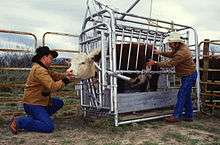Hug machine
A hug machine, also known as a hug box, a squeeze machine, or a squeeze box, is a deep-pressure device designed to calm hypersensitive persons, usually individuals with autism spectrum disorders. The therapeutic, stress-relieving device was invented by Temple Grandin while she was attending college.[1][2]
Autism and autism-spectrum disorders have profound effects upon both social interactions and sensitivity to sensory stimulation in persons with such conditions, often making it uncomfortable or impractical for them to turn to other human beings for comfort. Grandin solved this by designing the hug machine so both she and others could turn to it for sensory relief, when needed or simply desired.
Description
The hug machine consists of two hinged side-boards, each four by three feet (120 cm by 90 cm) with thick soft padding, which form a V-shape, with a complex control box at one end and heavy-duty tubes leading to an air compressor. The user lies or squats, between the side-boards, for as long or short a period as desired. Using pressure exerted by the air compressor and controlled by the user, the side-boards apply deep pressure stimulation evenly across the lateral parts of the body.[3] The machine and its development are depicted in the biopic Temple Grandin.[4]
History

As a young child, Grandin realized she would seek out deep pressure stimulation, but she felt over-stimulated when someone hugged or held her. The idea for the hug machine came to her during a visit to her aunt's Arizona ranch, where she noted the way cattle were confined in a squeeze chute for inoculation, and how some of the cattle immediately calmed down after pressure was administered. She realized that the deep pressure from the chute had a calming effect on the cattle, and she decided that something similar might well settle down her own hypersensitivity.
Initially, Grandin's device met with disapproval as psychologists at her college sought to confiscate her prototype hug machine.[2] Her science teacher, however, encouraged her to determine the reason it helped resolve the anxiety and sensory issues.
Efficacy
Several therapy programs in the United States now use hug machines, effectively achieving general calming effects among both children and adults with autism. A 1995 study on the efficacy of Grandin's device, conducted by the Center for the Study of Autism, working with Willamette University in Salem, Oregon, involved ten children with autism and found a reduction in tension and anxiety.[5] Other studies, including one by Dr. Margaret Creedon, have yielded similar results. A small pilot study published in the American Journal of Occupational Therapy reported that the machine produced a significant reduction in tension, but only a small decrease in anxiety.[6]
Grandin continued to use her own hug box on a regular basis to provide the deep pressure necessary to relieve symptoms of her anxiety. "I concentrate on how gently I can do it," she has said. Grandin has written a paper on her 'hug machine' and the effects of deep pressure stimulation that has been published in the Journal of Child and Adolescent Psychopharmacology.[3]
In a February 2010 Time magazine interview, Grandin stated that she no longer uses a hug machine: "It broke two years ago, and I never got around to fixing it. I'm into hugging people now."[7]
Squeeze chair
For several years in the 1990s, "urban interventionist"/artist Wendy Jacob worked with Grandin in developing furniture that squeezes or 'hugs' users, inspired by Grandin's hug machine.[8][9]
References
- ↑ Grandin, Temple (1996). Thinking in Pictures: Other Reports from My Life with Autism.
- 1 2 Grandin, Temple. Emergence: Labeled Autistic, p. 91. Warner Books, 1996.
- 1 2 Temple Grandin (Spring 1992). "Calming Effects of Deep Touch Pressure in Patients with Autistic Disorder, College Students, and Animals". Journal of Child and Adolescent Psychopharmacology. Mary Ann Liebert, Inc. 2 (1): 63–72. doi:10.1089/cap.1992.2.63. PMID 19630623.
- ↑ Temple Grandin at the Internet Movie Database
- ↑ Stephen M. Edelson, Ph.D. (6 December 2009). "Temple Grandin's Hug Machine". Salem, Oregon: Center for the Study of Autism. Retrieved 2011-11-09.
- ↑ Edelson, S.M., Edelson MG, Kerr DC, Grandin T (1999). "Behavioral and physiological effects of deep pressure on children with autism: a pilot study evaluating the efficacy of Grandin's Hug Machine". Am J Occup Ther. 53 (2): 145–52. doi:10.5014/ajot.53.2.145. PMID 10200837.
- ↑ Claudia Wallis (February 4, 2010). "Temple Grandin on Temple Grandin". Time Magazine. Retrieved 2010-10-22.
- ↑ Nikolovska, Lira; Ackermann, Edith; Cherubini, Mauro (2008). "Exploratory Design, Augmented Furniture?". In Pierre Dillenbourg; Jeffrey Huang; Mauro Cherubini. Interactive Artifacts and Furniture Supporting Collaborative Work and Learning. Computer-Supported Collaborative Learning Series. 10. Springer. pp. 156–157. ISBN 0387772340. Retrieved Feb 2014. Check date values in:
|access-date=(help) - ↑ "The Squeeze Chair Project". Wendy Jacob. Retrieved 7 February 2014.
External links
- Dr. Temple Grandin's Webpage: Livestock Behaviour, Design of Facilities and Humane Slaughter (Grandin.com)
- Description and schematic details of the squeeze machine (Grandin.com)
- Hug Machine Building Directions